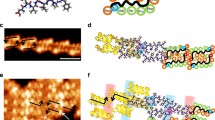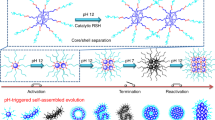Abstract
Construction of complex three-dimensional (3D) architectures through hierarchical self-assembly of peptide molecules has become an attractive approach of fabricating multifunctional advanced materials due to their various potential applications in bionanotechnology. This paper describes the tunable formation of flower-like 3D hierarchical architectures of intricate morphology from a simple self-assembling dipeptide phenylalanine–tyrosine with a facile preparative method by applying a range of voltages through a drop of peptide solution. The fine-tuning of voltages and their application time enable to produce morphological changes of the microstructures from 2D to 3D and also control their formation. The morphology has been characterized by the gradual change in the height-to-diameter ratio of the microstructures with change in the applied voltages. Moreover, these microstructures show significant thermal stability over a wide range of temperatures, whereas adequately high temperature promotes the morphological transformation of the microstructures into different types of ultrathin 1D nanostructures such as nanowires, nanofibrils, etc. Furthermore, we have suggested a possible growth model for the fabrication of unique hierarchical architectures through diffusion-limited aggregation mechanism.







Similar content being viewed by others
References
Whitesides GM, Grzybowski B (2002) Self-assembly at all scales. Science 295:2418–2421
Zhang S (2003) Fabrication of novel biomaterials through molecular self-assembly. Nat Biotechnol 21:1171–1178
Palmer LC, Stupp SI (2008) Molecular self-assembly into one-dimensional nanostructures. Acc Chem Res 41:1674–1684
Gazit E (2010) Bioinspired chemistry: diversity for self-assembly. Nat Chem 2:1010–1011
Ulijn RV, Smith AM (2008) Designing peptide based nanomaterials. Chem Soc Rev 37:664–675
Ball P (1999) The self-made tapestry. Oxford University Press, Oxford
Sanchez C, Arribart H, Guille MMG (2005) Biomimetism and bioinspiration as tools for the design of innovative materials and systems. Nat Mater 4:277–288
Noorduin WL, Grinthal A, Mahadevan L, Aizenberg J (2013) Rationally designed complex, hierarchical microarchitectures. Science 340:832–837
Lehn J-M (2013) Perspectives in chemistry—steps towards complex matter. Angew Chem Int Ed 52:2836–2850
Jeon TY, Jeon HC, Lee SY, Shim TS, Kwon J-D, Park S-G, Yang S-M (2014) 3D hierarchical architectures prepared by single exposure through a highly durable colloidal phase mask. Adv Mater 26:1422–1426
Wang A, Huang J, Yan Y (2014) Hierarchical molecular self-assemblies: construction and advantages. Soft Matter 10:3362–3373
Tirrell DA (1994) Hierarchical structures in biology as a guide for new materials. National Academy Press, Washington, DC
Vukusic P, Sambles JR (2003) Photonic structures in biology. Nature 424:852–855
Chu K-H, Xiao R, Wang EN (2010) Uni-directional liquid spreading on asymmetric nanostructured surfaces. Nat Mater 9:413–417
Aizenberg J, Weaver JC, Thanawala MS, Sundar VC, Morse DE, Fratzl P (2005) Skeleton of Euplectella sp.: structural hierarchy from the nanoscale to the macroscale. Science 309:275–278
Gansel JK, Thiel M, Rill MS, Decker M, Bade K, Saile V, Freymann G, Linden S, Wegener M (2009) Gold helix photonic metamaterial as broadband circular polarizer. Science 325:1513–1515
Ge J, Lei J, Zare RN (2012) Protein–inorganic hybrid nanoflowers. Nat Nanotechnol 7:428–432
Silva GA, Czeisler C, Niece KL, Beniash E, Harrington DA, Kessler JA, Stupp SI (2004) Selective differentiation of neural progenitor cells by high-epitope density nanofibers. Science 303:1352–1355
Kiyonaka S, Sada K, Yoshimura I, Shibkai S, Kato N, Hamachi I (2004) Semi-wet peptide/protein array using supramolecular hydrogel. Nat Mater 3:58–64
Nakanishi T (2010) Supramolecular soft and hard materials based on self-assembly algorithms of alkyl-conjugated fullerenes. Chem Commun 46:3425–3436
Jayawarna V, Ulijn RV (2012) In: Gale PA, Steed JW (eds) Supramolecular chemistry: from molecules to nanomaterials, vol 7. Wiley, Chichester, p 3525–4013
Abramovich LA, Gazit E (2014) The physical properties of supramolecular peptide assemblies: from building block association to technological applications. Chem Soc Rev 43:6881–6893
Handelman A, Beker P, Amdursky N, Rosenman G (2012) Physics and engineering of peptide supramolecular nanostructures. Phys Chem Chem Phys 14:6391–6408
Yan X, Zhu P, Li J (2010) Self-assembly and application of diphenylalanine-based nanostructures. Chem Soc Rev 39:1877–1890
Zelzer M, Ulijn RV (2010) Next-generation peptide nanomaterials: molecular networks, interfaces and supramolecular functionality. Chem Soc Rev 39:3351–3357
Hadjichristidis N, Tezuka Y, Prez DF (2011) Complex macromolecular architectures: synthesis, characterization, and self-assembly. Wiley, Hoboken
Yuran S, Razvag Y, Reches M (2012) Coassembly of aromatic dipeptides into biomolecular necklaces. ACS Nano 6:9559–9566
Su Y, Yan XH, Wang A, Fei JB, Cui Y, He Q, Li JB (2010) A peony-flower-like hierarchical mesocrystal formed by diphenylalanine. J Mater Chem 20:6734–6740
Panciera M, Amorín M, Granja JR (2014) Molecular pom poms from self-assembling α,γ-cyclic peptides. Chem Eur J 20:10260–10265
Mart RJ, Osborne RD, Stevens MM, Ulijn RV (2006) Peptide-based stimuli-responsive biomaterials. Soft Matter 2:822–835
Mason TO, Chirgadze DY, Levin A, Abramovich LA, Gazit E, Knowles TPJ, Buell AK (2014) Expanding the solvent chemical space for self-assembly of dipeptide nanostructures. ACS Nano 8:1243–1253
Koley P, Gayen A, Drew MGB, Mukhopadhyay C, Pramanik A (2012) Design and self-assembly of a leucine–enkephalin analogue in different nanostructures: application of nanovesicles. Small 8:984–990
Koley P, Pramanik A (2012) Multilayer vesicles, tubes, various porous structures and organo gels through the solvent-assisted self-assembly of two modified tripeptides and their different applications. Soft Matter 8:5364–5374
Demirel G, Buyukserin F (2011) Surface-induced self-assembly of dipeptides onto nanotextured surfaces. Langmuir 27:12533–12538
Qin S-Y, Xu S-S, Zhuo R-X, Zhang X-Z (2012) Morphology transformation via pH-triggered self-assembly of peptides. Langmuir 28:2083–2090
Koley P, Pramanik A (2014) pH-sensitive morphological transition from nanowire to nanovesicle of a single amino acid-based water soluble molecule. J Mater Sci 49:2000–2012. doi:10.1007/s10853-013-7887-3
Williams RJ, Smith AM, Collins R, Hodson N, Das AK, Ulijn RV (2009) Enzyme-assisted self-assembly under thermodynamic control. Nat Nanotechnol 4:19–24
Wang W, Chau Y (2009) Self-assembled peptide nanorods as building blocks of fractal patterns. Soft Matter 5:4893–4898
Kwak J, Lee S-Y (2013) Enhanced photoluminescence by tyrosine-containing bolaamphiphile self-assembly. Langmuir 29:4477–4484
Ding Y, Li Y, Qin M, Cao Y, Wang W (2013) Photo-cross-linking approach to engineering small tyrosine-containing peptide hydrogels with enhanced mechanical stability. Langmuir 29:13299–13306
Abramovich LA, Reches M, Sedman VL, Allen S, Tendler SJB, Gazit E (2006) Thermal and chemical stability of diphenylalanine peptide nanotubes: implications for nanotechnological applications. Langmuir 22:1313–1320
Ryu J, Park CB (2010) High stability of self-assembled peptide nanowires against thermal, chemical, and proteolytic attack. Biotechnol Bioeng 105:221–230
Handelman A, Natan A, Rosenman G (2014) Structural and optical properties of short peptides: nanotubes-to-nanofibers phase transformation. J Pept Sci 20:487–493
Semin S, Etteger A, Cattaneo L, Amdursky N, Kulyuk L, Lavrov S, Sigov A, Mishina E, Rosenman G, Rasing T (2014) Strong thermo-induced single and two-photon green luminescence in self-organized peptide microtubes. Small. doi:10.1002/smll.201401602
Surmacz-Chwedoruk W, Malka I, Bożycki Ł, Nieznańska H, Dzwolak W (2014) On the heat stability of amyloid-based biological activity: insights from thermal degradation of insulin fibrils. PLoS ONE 9:e86320 (1–7)
Sakurai M, Koley P, Aono M (2014) A new approach to molecular self-assembly through formation of dipeptide-based unique architectures by artificial supersaturation. Chem Commun 50:12556–12559
Adams DA (2011) Dipeptide and tripeptide conjugates as low-molecular-weight hydrogelators. Macromol Biosci 11:160–173
Koley P, Pramanik A (2011) Nanostructures from single amino acid-based molecules: stability, fibrillation, encapsulation, and fabrication of silver nanoparticles. Adv Funct Mater 21:4126–4136
Baldwin RL (1986) Temperature dependence of the hydrophobic interaction in protein folding. Proc Natl Acad Sci USA 83:8069–8072
Matsumura M, Becktel WJ, Matthews BW (1988) Hydrophobic stabilization in T4 lysozyme determined directly by multiple substitutions of Ile 3. Nature 334:406–410
de la Rica R, Matsui H (2010) Applications of peptide and protein-based materials in bionanotechnology. Chem Soc Rev 39:3499–3509
Saito Y (1996) Statistical physics of crystal growth. World Scientific, Singapore
Scheffela A, Poulsena N, Shianb S, Kröger N (2011) Nanopatterned protein microrings from a diatom that direct silica morphogenesis. Proc Natl Acad Sci USA 108:3175–3180
Marshall KE, Robinson EW, Hengel SM, Paša-Tolić L, Roesijadi G (2012) FRET imaging of diatoms expressing a biosilica-localized ribose sensor. PLoS ONE 7:e33771 (1–8)
Wiersma DS (2013) Disordered photonics. Nat Photon 7:188–196
Acknowledgements
This work was supported in part by the World Premier International Center (WPI) Initiative on Materials Nanoarchitectonics, MEXT, Japan, and in part by JPSP KAKENHI (24241047).
Author information
Authors and Affiliations
Corresponding authors
Electronic supplementary material
Below is the link to the electronic supplementary material.
Rights and permissions
About this article
Cite this article
Koley, P., Sakurai, M. & Aono, M. Tunable morphology from 2D to 3D in the formation of hierarchical architectures from a self-assembling dipeptide: thermal-induced morphological transition to 1D nanostructures. J Mater Sci 50, 3139–3148 (2015). https://doi.org/10.1007/s10853-015-8875-6
Received:
Accepted:
Published:
Issue Date:
DOI: https://doi.org/10.1007/s10853-015-8875-6




